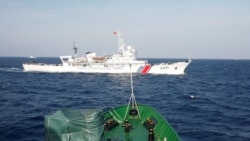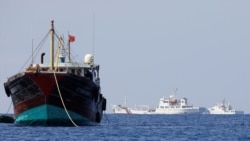Researchers say sea life in the South China Sea continues to suffer damage because of overfishing and a lack of international action to protect the area.
Over the past year, fishing operations from several Asian countries have moved farther out into the 3.5 million-square-kilometer sea, experts and public research suggest. The fishermen are finding more success in deeper ocean waters than in overfished coastal areas.
Ocean coral was further damaged last year as a result of large clam operations and the use of cyanide and dynamite in fishing, researchers said.
China claims most of the South China Sea as its territory. Brunei, Malaysia, the Philippines, Taiwan and Vietnam also claim parts of the sea. China has angered other claimants in recent years by creating small man-made islands in some disputed areas of the sea and building military equipment on some of the land.
Attention turns to sea life in the waterway every May, when China declares a temporary halt to fishing above the 12th parallel. This is an area that covers waters mostly used by China, but also areas near Vietnam and the Philippines. The yearly fishing ban began in 1995. This year, the ban runs from May 1 to August 16.
Gregory Poling is director of the Asia Maritime Transparency Initiative at the Washington-based Center for Strategic and International Studies, or CSIS. He told VOA that damage to sea life in the South China Sea is clearly worsening. He added, “We certainly don’t see any evidence that anybody is doing anything about it.”
Fishing in the sea quickly expanded in the 1980s and early 1990s, when it reached about 10 million tons per year. Those numbers come from a 2017 study. The lead researchers of the study -- Cui Liang of China’s Xiamen University and Daniel Pauly from the University of British Columbia -- said fishing activities leveled off after that expansion.
In recent years, boats have been fishing in deeper waters and catching smaller fish. Five years ago, fishing in the South China Sea accounted for 12 percent of the worldwide fish catch, CSIS estimates show.
Herman Kraft is a political science professor at the University of the Philippines Diliman. He told VOA that coastal areas are already overfished. So, fishing operations from China, Taiwan, Korea, and Japan are moving toward the center of the South China Sea.
The environmental group Global Underwater Explorers says dynamite and cyanide bombing is causing major damage to sea life. Such activities are “widespread throughout Asia and the South China Sea, from Indonesia to southern China,” the group says on its website.
Large clam harvesting last year by Chinese boats harmed large coral around Scarborough Shoal west of Luzon Island in the Philippines, media organizations in Manila reported.
The World Wildlife Fund said on its website that military groups in the sea’s Spratly Islands have shot turtles and seabirds and fished with explosives.
The decreasing fish supplies are pushing each country to increase its activities to look harder for what is left, Poling said.
About 4 million Chinese fishing crew members are expected to obey China’s temporary fishing ban. But crews from countries that dispute those parts of the sea are not likely to do so because they do not recognize China’s claims.
I’m Bryan Lynn.
Ralph Jennings reported this story for VOA News. Bryan Lynn adapted the report for Learning English. Ashley Thompson was the editor.
We want to hear from you. Write to us in the Comments section, and visit our Facebook page.
________________________________________________________________
Words in This Story
coral – n. a hard, usually pink or white substance produced by a type of a very small sea animal
level off – phrasal verb. to stop rising or falling and stay at the same level
clam – n. a small sea creature that has a shell in two parts
turtle – n. an animal with four legs and a hard shell that lives mainly in water
cyanide – n. a very strong poision
dynamite – n. a type of explosive










